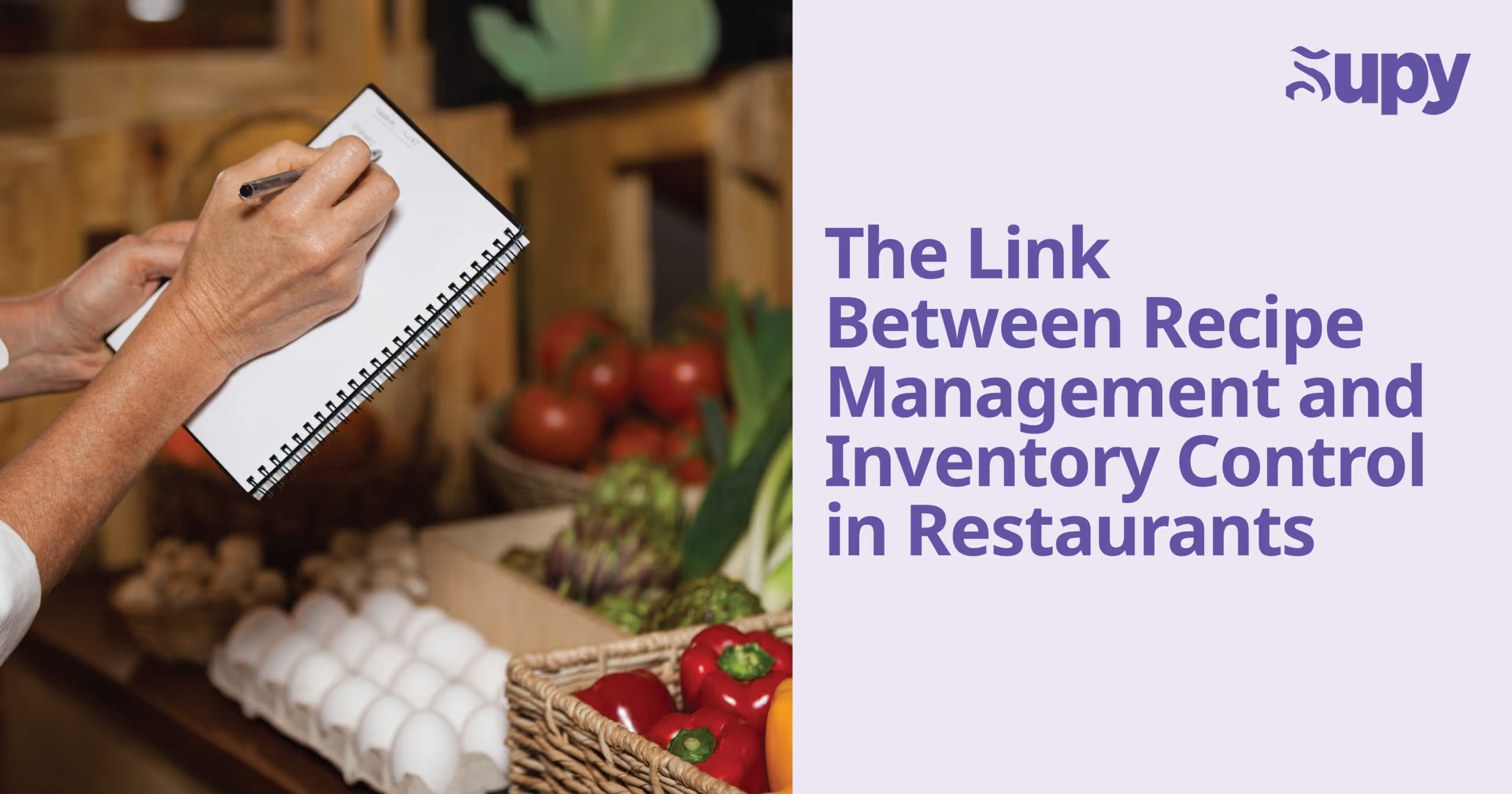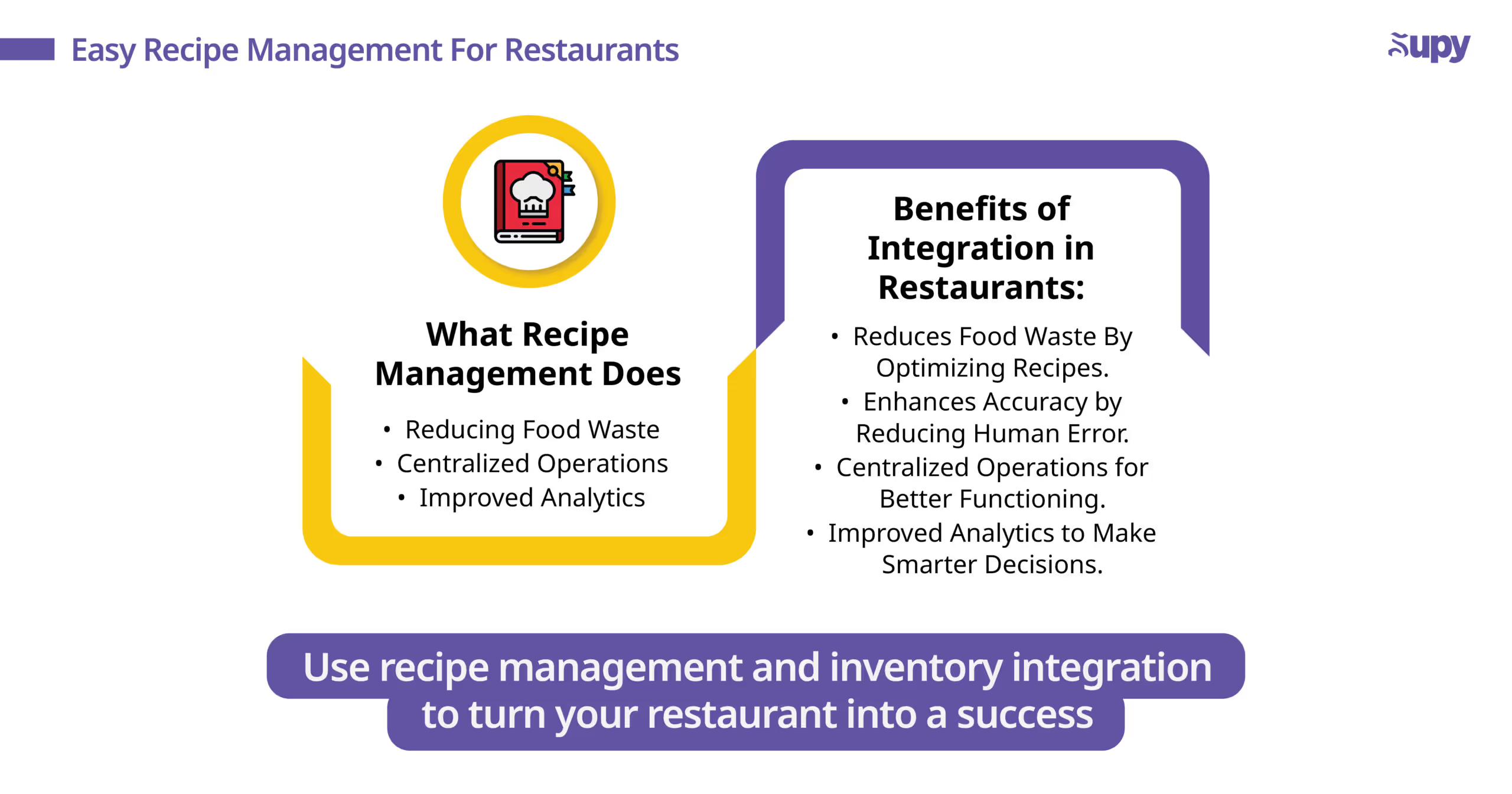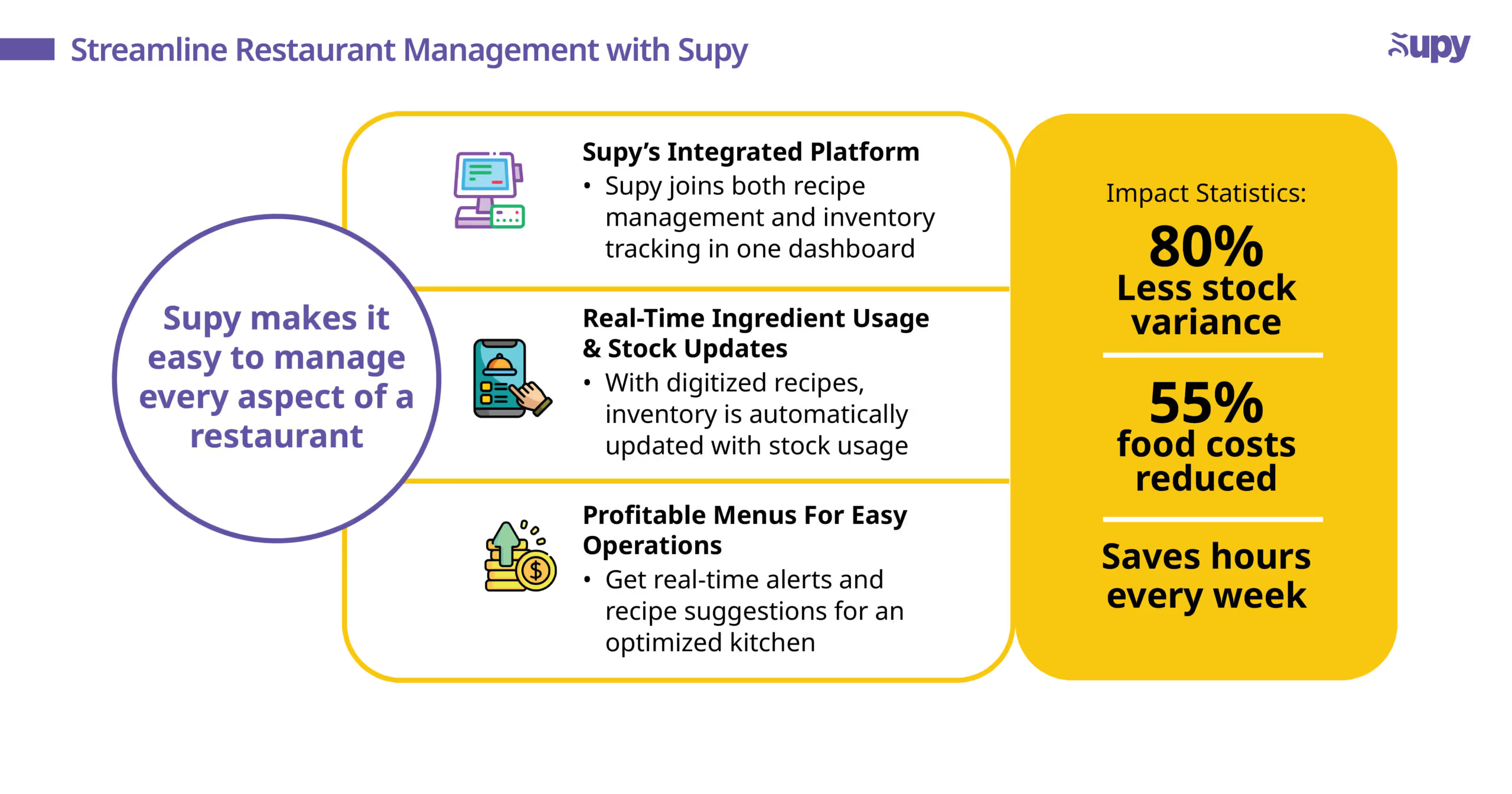The Link Between Recipe Management and Inventory Control in Restaurants

- Introduction
- What is Recipe Management Software?
- Understanding Inventory Systems in Culinary Businesses
- The Importance of Integrating Recipe Management with Inventory Systems
- How Supy Integrates Recipe Management with Inventory System
- Features of Supy’s Integration Tools
- Future of Recipe and Inventory Management Systems
- Conclusion
- About Supy
1. Introduction
Running a successful restaurant isn't just about crafting great recipes and maintaining a well-stocked kitchen, it’s about ensuring that both work in harmony. While menu planning, a central kitchen, and skilled staff are essential, inventory management is just as critical. Yet, many restaurants overlook the direct relationship between inventory control and recipe management, treating them as separate processes rather than two sides of the same coin.
Inventory exists to support recipes, but when there’s a disconnect between the two, it leads to inconsistent quality, stock shortages, unnecessary waste, and profit loss. Even the most well-optimized inventory system can fall short if recipes aren’t structured and tracked effectively.
The reality is that recipe management and inventory control must work together to ensure efficiency, cost control, and consistency across all operations. Restaurants that master this relationship streamline purchasing, minimize waste, and optimize food costs. While it may seem complex, implementing the right strategies and tools makes this process seamless and highly rewarding.
2. What is Recipe Management Software?
Recipe management is the act of creating and managing relationships between a restaurant’s production, inventory, recipes, and other factors. It is essential in ensuring full utilization of ingredient stocks and minimizing wastage.
Therefore, recipe management software is any tool that’s used to conduct recipe management on a larger and more precise scale. This software often includes various functions that let a recipe manager determine relationships between variables almost instantly.
Core Features of Recipe Management Software
Although each recipe management system is different, there are some core features that most of them generally have. These features help you stay on top of how recipes are performing and make any required changes.
- Tools to help with recipe creation, menu editing, and portion sizes
- Breakdown of cost analysis and automated food cost calculations
- Ways to engineer recipes for maximum sales and profit
- Insights on nutritional values, recipe data, and allergen tracking
- Tips on menu planning and scaling for multiple franchises
Depending on the recipe management software, there could be more or fewer features than the one mentioned. It’s important to choose software that meets your restaurant’s needs.
Benefits of Recipe Management Software
Recipe management software is essential for running a successful restaurant. Some of these benefits are:
- With the right management tools you can control ingredient costing and recipe parameters at your restaurant so capital isn’t tied up.
- Automated recipes with real-time insights reduce the error margin and help boost kitchen efficiency.
- Recipe management software also streamline many tasks and save you multiple hours a week to allocate to other issues
3. Understanding Inventory Systems in Culinary Businesses
Menu and recipe engineering isn’t the only area where a technological revolution influenced restaurant management software. Another great advancement that most restaurants have started to make use of is inventory systems. Inventory systems are software and programs that keep track of a restaurant's inventory stock, its changes, and the ways in which it is used.
Key Functions of Inventory Systems
Managing a restaurant’s culinary operations and stock can be very hard without a proper inventory system. Some of the key functions of such a tool are:
- Ensuring consistency in stocking and inventory while keeping an eye on factors such as variance.
- Identifies any stock that is slowly moving and not properly utilized to account for wastage that occurs and how to stop.
- Analyzes consumption trends to predict a reliable demand estimate for future ordering of stocks in restaurants.
Depending on what your inventory system is linked to - its functions can change, too. Most people link inventory to POS systems for better data on sales, while others prefer to link it with procurement platforms.
Common Challenges Without Integration
Although integration with different systems is common when running a restaurant, many owners often overlook integrating recipe software and inventory systems. Without proper integration, a lot can go wrong on the back end.
For starters, it would take manual input of sales and inventory consumption to keep analytics and trends up to date. There’s always room for error when human computing is involved, and this can lead to overstocking, inaccurate recipe costing, and food wastage.
Similarly, a lack of integration means keeping up with recipe and inventory management is either going to be a two-person job, or it’ll take additional hours. This inefficiency leads to higher billed hours and uses precious team time that can be directed towards improving the restaurant. Instead, teams are busy managing recipes when all your recipes and recipe ingredients can be taken care of via automation.
4. The Importance of Integrating Recipe Management with Inventory Systems

To avoid the aforementioned issues, it is essential to integrate recipe management with inventory systems in a restaurant. Business owners may find that there are many integration options available, but it's best to either use a platform that offers both services or separate services that are compatible with one another.
Many people choose to go for restaurant management software that provides multiple features like inventory management, analytics, POS setup, and recipe management as well. It makes the entire process easier and gives you a central dashboard to supervise your restaurant.
Pros and Cons of Integration
Pros
Cons
With automated data entry, the chances of human error in inventory and recipe updates are significantly reduced.
Initial setup and integration of recipe management software and inventory systems can be costly.
Shows actual ingredient consumption from inventory stocks and helps tweak recipes for better stock utilization and less food waste.
The existing staff may need to be trained to use such modern technology.
Clears communication between the procurement and kitchen teams so both are on the same page with inventory demand and supply.
Owners must make sure existing computer systems are compatible with integration requirements.
Updated analytics and reporting give you a good basis to make informed management decisions.
5. How Supy Integrates Recipe Management with Inventory Systems

Managing every aspect of a restaurant can be hard, especially when you’re focusing on inventory and recipes in all your restaurants. That’s where you need a platform like Supy that streamlines automated restaurant management to boost sales and streamline operations. With Supy, any management task at your restaurant is a piece of cake.
Supy’s Integration Process
Supy has a built-in recipe management and inventory tracking feature in its management system. Forget about finding compatible tools; this software includes everything you need. Since everything is included in the package, you can access both inventory and recipe management from the same dashboard.
By digitizing the menu list and recipes, Supy automatically tracks ingredient usage based on preparation and sales. This ingredient usage is deduced directly from the inventory while stock levels are updated. Not only does this real-time representation lead to better management, but it also leaves less room for ambiguity and guessing.
With features such as food cost alerts, precision preparation, real-time cost tracking, and revenue stimulation, restaurants can make a profitable menu with optimized recipes. Through inventory management, partnering with Supy leads to the following:
- Up to 80% less stock variance
- 55% food cost reduction
- Up to 10 hours saved per week
6. Features of Supy’s Integration Tools
Supy offers many tools to help improve a restaurant’s culinary operations and inventory management. Some of these are:
- Menu Engineering: This feature lets you create accurate recipes that don’t leave room for ingredient wastage. Not only are these recipes accurate, they’re easy to reproduce and can be tweaked whenever needed. Any changes are immediately accounted for and updated across all analytics as well.
- Inventory Management: Another useful tool offered on Supy’s platform is inventory management. You can keep track of stock rates and reduce variance by a great deal. The tool integrates with POS systems and other data-input sources to constantly update how much stock is being used and account for waste management, too.
- Real-Time Syncing: Once your systems are integrated into both the kitchen and inventory, Supy ensures real-time syncing for any changes in data. As things happen in your restaurant, they’ll be updated and added. If you happen to sell an X amount of a certain item on the menu, then your stock analysis will account for that change as soon as it's entered into the system.
- Automated Stock Adjustments: Unlike traditional software that requires you to give commands to check stock variance and levels, Supy gets the job done before you even ask. As orders are placed, Supy automatically adjusts the stock to factor in ingredients that are being used up. Plus, once inventory stock hits a low level, it automatically sends alerts to restock.
- Updated Analytics and Reporting: With all its features, Supy also offers you instantly updated analytics and reports on an ad-hoc and periodic base. These reports help restaurants audit their inventories, manage supply-chain constraints, balance stock levels, and optimize recipes for minimal waste. If you’re a restaurant owner or manager, these analytics will help you make informed decisions.
Get Technical Simplicity with Supy
Supy gets rid of the awkwardness of dealing with managing software that’s hard to operate. Not everyone is a tech wizard, and the platform takes that into consideration. With Supy, technical issues are the least of a restaurant owner’s concerns. It has a simple interface that is easy to use and instantly gets you the reports, analytics, and tools you’re looking for.
Apart from being accessible via a computer, Supy is also mobile phone friendly! You can take your restaurant management on the go and stay updated with live alerts. Whether it's reordering stocks or tweaking recipes for better optimization, you don’t have to wait to be at your desk to get the job done.
7. Future of Recipe and Inventory Management Systems

The restaurant management landscape is constantly changing due to emerging technologies. With newer software and platforms that overlook the essential aspects of running things, Artificial Intelligence and Machine Learning seem to be paving the way.
AI and ML help fasten computation and create real-time analysis between various factors and trends. Not only does it help save time, but it brings everything readily available at the fingertips of restaurant owners. Moreover, AI provides insights into consumer trends and how to make changes to existing recipes and operations.
Restaurant owners need to embrace these changing technologies as they only improve the dining experience for customers. By having reliable data-driven and pattern-based decision-making, one can reduce human errors and work towards running a more efficient workplace. When the load of trivial computation and tasks is taken off the team, they’re free to improve teamwork and other aspects of running an eatery.
8. Conclusion
There’s a lot that goes into running a successful restaurant, but integrated recipe management software and inventory systems is a crucial step. With an integrated kitchen and inventory, restaurant owners can focus much-needed attention on creative development and expansion - and above all else - customer satisfaction.
If keeping your recipe management and inventory systems interconnected seems like too much work for you and your team, partnering up with Supy might be the solution. Supy’s business model fits all sorts of eaters and restaurants, regardless of what they specialize in. All you need is to book a free demo, and Supy will show you how efficient your business can be.
Ready to see the Supy difference? Schedule a demo with us!
9. About Supy
Supy is a restaurant management software platform that includes features to integrate the kitchen, inventory, accounts, and other sectors of management. It helps restaurant owners make the best decisions for their business based on real-time analytics and customer trends.
With Supy as a partner, you can look forward to several hours of reduced managerial workload a week. Its like having an extra pair of hands on board that keeps an eye on all things and alerts you timely on the areas that need your attention.
If you’re looking to open more franchises whilst having a central kitchen, check out this ebook on The Ultimate Guide to Opening a Central Kitchen for Multi-Branch F&B Businesses.







